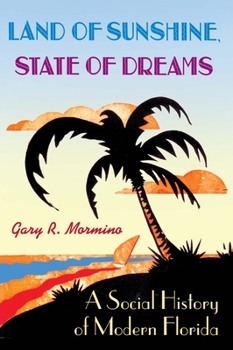Land of Sunshine, State of Dreams: A Social History of Modern Florida
(Part of the The Florida History and Culture Series Series)
Select Format
Select Condition 
Book Overview
"This path-breaking book brilliantly explains the explosive growth of Florida from 2.7 million inhabitants in 1950 to 15.9 million in 2000. It focuses on the diverse people who migrated here; the developers of tourism, beaches, shopping malls, and gated communities; new technology (from air conditioning to the space age); and the impact of this growth and development upon the environment."--James B.Crooks, professor emeritus, University of North...
Format:Paperback
Language:English
ISBN:081303308X
ISBN13:9780813033082
Release Date:August 2008
Publisher:University Press of Florida
Length:460 Pages
Weight:1.50 lbs.
Dimensions:1.2" x 6.1" x 9.0"
Customer Reviews
4 ratings
Excellent Socio-Cultural Expose on Florida Demographics
Published by Thriftbooks.com User , 14 years ago
This book: Land of Sunshine--- was a real eyeopener on the reasons for Florida's extreme population surge in the second half of the 20th Century.
Fantastic Read
Published by Thriftbooks.com User , 17 years ago
As a new resident of Florida, I wanted to "get up to speed" on the history of Florida, specifically since 1950. This book covers modern Florida's history very well. I liked the book so much, I am half-way through my second read of it. Very highly recommended.
Reviews from the Florida Humanities Council Website
Published by Thriftbooks.com User , 19 years ago
"...a fascinating, original, and lucid history of the nation's fourth largest state...essential reading for anyone interested in past and present Florida." - Merle Black, co-author of The Rise of Southern Republicans "...the first comprehensive social history of Florida in any of its epochs...the standard against which all future such efforts in Florida will be measured." - Michael Gannon, professor emeritus, University of Florida
Waking in the Land of Dreams
Published by Thriftbooks.com User , 19 years ago
Gary Mormino's ambitious book Land of Sunshine... is an artful contribution to the thin historiography of modern Florida. Picking up after the end of World War II, Mormino shows how new technology and cultural trends shaped the history, population, and land of Florida. Unlike most academic writers, he employs an eloquent but casual style free of jargon and mind-numbing analysis. Thankfully, this important book is written for laymen, but provides just as many insights for academics and officials. Equally welcome is a focus upon the "people" over the "politicians." It could easily be argued, even today, that developers, businessmen, visitors, and citizens play a more important role in the life and mythmaking of the Sunshine State than political operatives, especially when one takes into account the Florida Legislature. The research itself is superb, and I am in a position to know-I sometimes helped him in his sustained effort. If the U.S. is relatively uninterested in scrutinizing its own history, Florida hardly seems to have a history at all. In a state full of unconcerned Snow Birds, oblivious tourists, and new immigrants, Florida's history seems to have started when Disney World opened in 1971. Thanks to Mormino's work, the last sixty years of Florida's amazing history are illuminated. And what a last sixty years! Although a comprehensive review would take too much space here, the subjects of the book's chapters tell a story in themselves. The first, "Look away Dixieland," provides a fine introduction to the places that make Florida unique. The next tackles the "new land boom" of the 1950s and beyond (did it ever really end?), when common folks from the northeast and Midwest could afford to move to and/or retire in Florida. Of course, there are also the developers, whose sometimes-good intentions were often outweighed by their desire for quick profit. Logically, a chapter about tourism follows, documenting Florida's funky roadside showcases as well as the more elaborate and contrived tourist empires such as Disney World. Another chapter covers retirement in Florida, from Miami Jews to the active residents of Sun City Center, who were "too busy to retire." Of course, St. Petersburg's green benches make an appearance as well. In "Sunbelt Hues," Mormino makes sense of the impact of international politics (Cold War, Space Race, etc.) and Florida's overheated financial marketplace, all the time acknowledging the unforeseen consequences of government spending, corporate developments, and low-paying service jobs. Agriculture in the state has had similarly mixed results, bringing nationally known agricultural products to market while saturating the land and water with pollutants and poisons. His chapter on technological change, highlighting such misguided projects such as the barge canal, further demonstrates that there is no free lunch: every development, from A/C to DDT, can cast an ugly shadow. The rising tide of immigratio





